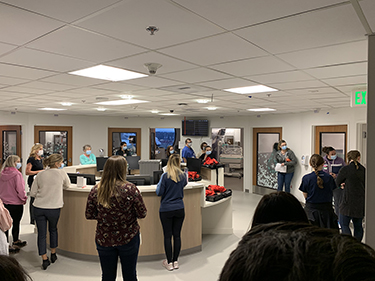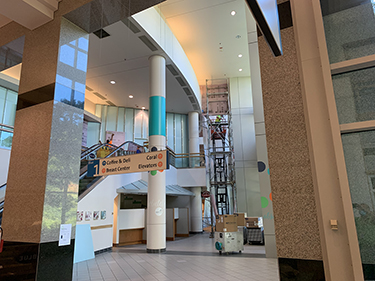|
Subscribe / Renew |
|
|
Contact Us |
|
| ► Subscribe to our Free Weekly Newsletter | |
| home | Welcome, sign in or click here to subscribe. | login |
Construction
| |
 |
April 1, 2022
What it takes to build health and science projects
Aldrich + Associates

Ward
|
This year marks Aldrich + Associates’ 50th anniversary. We have practiced health care construction for nearly all our 50-year history, from constructing clinics and office buildings for private practice doctors in the 1970s and ‘80s to recent projects at some of the Puget Sound’s premier facilities. Today, we focus solely on health and science projects.
Our specialization in this area has been very rewarding and we love sharing our knowledge and our passion. In this article, we’ll share our insights about the unique requirements that come with construction in these complex environments, highlight some of the key benefits to facility owners and project teams that come from engaging health and science project specialists, and explore some of the trends and best practices we’re seeing in project delivery.
UNIQUE REQUIREMENTS
Nimble and flexible: Working in a patient care area or active laboratory often comes with strict requirements for noise and vibration control with access restrictions that can change due to operational circumstances. The ability to quickly shift focus and resources is a key factor to staying productive and moving a project forward without impacting care, especially in perioperative and critical care environments, where change can happen on a moment’s notice.
For example, in our work on CHI Franciscan St. Joseph Medical Center’s Neonatal Intensive Care Unit, we coordinated down-to-the-minute plans with nursing staff to ensure safety for these vulnerable patients. This sometimes involved running to an adjacent floor to make sure nurses could put earmuffs on neonates prior to drilling and, providing phone numbers so nurses could immediately reach our project leads if a baby’s condition changed or there was an unexpected delivery. When NICU staff needed quiet or a hallway cleared immediately, our team was there to get it done.
Extensive communication: Another key requirement, especially in occupied health care environments, is making sure all staff fully understand the nature and implications of upcoming work. One tool we use to support ongoing communication is an activity-specific method-of-procedure document that includes visuals of affected/unaffected areas and down-to-the-hour scope detail, required safety precautions, and infection control measures.
Other strategies we use include simplified color-coded phasing plans with dates and marking the location of temporary walls with blue tape on the floor well in advance of construction activities so staff can familiarize themselves with the new traffic patterns. Daily huddle meetings with health care providers and weekly recap emails with progress photos and details about upcoming tasks/deliveries are all part of Aldrich’s commitment to keep everyone involved in the project well-informed.
SPECIALIZED APPROACH
Budget accuracy: For facility owners and project teams, having reliable cost data is a key element to support decision-making that guides a project’s design. A contractor with extensive, successful health care experience is likely to have representative unit pricing and historical cost data that they can use for reference. Since this is all that we do, we have customized our estimating tools for health and science projects. Combined with our extensive historical cost database, this enables us to provide reliable cost information at the earliest stages of a project and anticipate how the design will progress as it relates to the project budget.
Creativity: There are many different types of environments included under the umbrella of health and science facilities, requiring openness to diverse perspectives and creative ideas from both designers and contractors. For example, EvergreenHealth’s Family Maternity Center included a two-story, 41-foot-tall atrium that required an infection control barrier. Similar atria in airports came to mind as our team looked at the cavernous space, and we developed a barrier solution using scaffolding to anchor our fire-retardant plastic along with 2-inch rigid foam to reduce noise transfer. These measures turned out to be an excellent and effective solution for this unique space.
Knowledge sharing: The strict codes and requirements combined with the variety of space types in health and science makes partnership and knowledge sharing between designers, contractors, and owners a key factor in devising effective and innovative solutions. We hold a Thursday morning superintendent’s huddle, a Friday project engineer’s huddle, and a Monday project manager’s huddle.
These huddles often lead to teams sharing creative approaches and resources to support each other and bring the value of our company’s collective wisdom to every project. For example, we had one project team constructing modular patient rooms at EvergreenHealth, and another team looking for the right solution for an ophthalmology clinic for Northwest Eye Surgeons (NWES). We proposed the modular idea to NWES and it ended up working best for them as well. Our teams also keep an ear to the ground on material availabilities — a particularly relevant topic as supply chain disruptions continue to challenge all construction projects.
BEST PRACTICES
Design-build and integrated models: More owners, such as University of Washington, Moses Lake Community Health Centers, and Northwest Kidney Centers continue to adopt design-build and other alternative delivery methods. The goal of design-build and other models like it is to create a more integrated and collaborative approach between owners, designers, and contractors. Integrated models can also shorten project timelines, which supports the owner’s speed to market goals.
We believe in the value of this integrated approach. As such, most of our project management staff is DBIA certified, with the plan to have all management team members complete certification within the next two years.
Trust and transparency between all team members are the cornerstones of maximizing these integrated processes. We encourage this environment through team partnering and developing project charters, full team kickoff meetings that get all parties on the same page, and regular project executive meetings where leaders from all key parties, owner included, can speak openly about project progress and challenges.
Expanding and changing care: We’re seeing more primary and specialty care centers opening in communities and rural areas. This expansion correlates with implementation of the Affordable Care Act and population shifts out of expensive metro areas. Health care communities have also increased investments in behavioral health, residential treatment facilities, elective surgeries for a growing aging population, and user-centered biophilic design approaches that support decreased patient mortality rates and decreased staff absenteeism and turnover. More specialty centers and designs that incorporate user feedback and connectivity to the natural environment mean even greater diversity of environments that require specialized capabilities from the design and construction community.
Many owners continue to invest in practice flow study and operational efficiency to streamline the patient/provider experience. All of these trends are important to understand so that we can ask the right questions early, support reliable decision-making, and help bring best value for our clients and their patients.
Although we only practice in one market, we find there’s never a dull moment. Together with owners and designers, we’re tackling some of the more complex challenges in the built environment and supporting our communities through the places they go for care. We’re proud to specialize in health and science construction.
George Ward is president of Aldrich + Associates.
Other Stories:
- A boost for health care education at Bates Tech
- Don’t ignore new compliance requirements
- Designing a healing river in Sequim
- The lab building of the future is NEXT
- The challenge of fighting climate change Health
- It’s time to rethink health care design
- A cancer care model with all the right amenities




